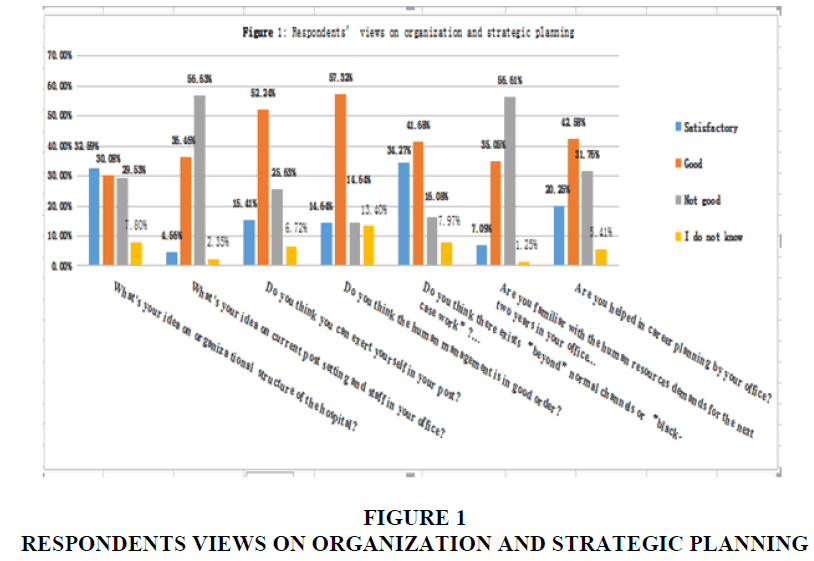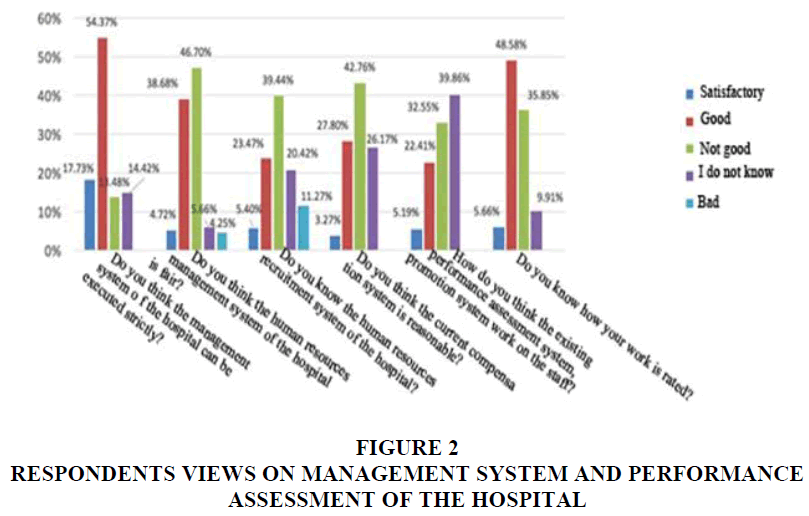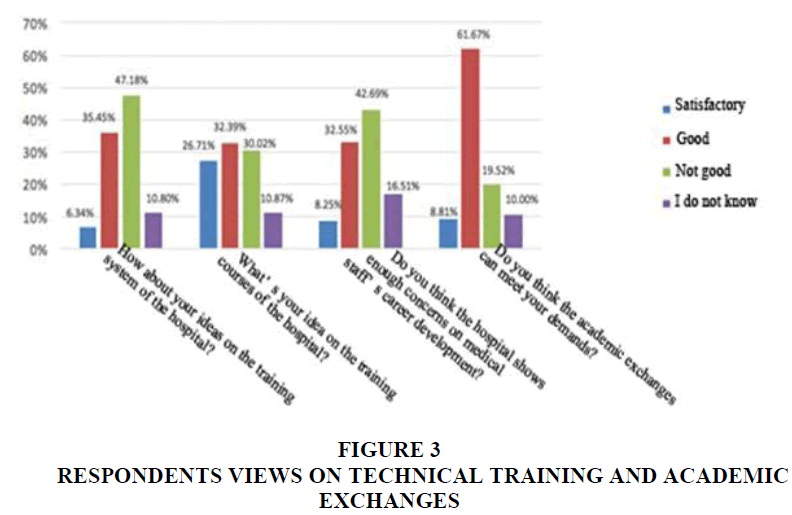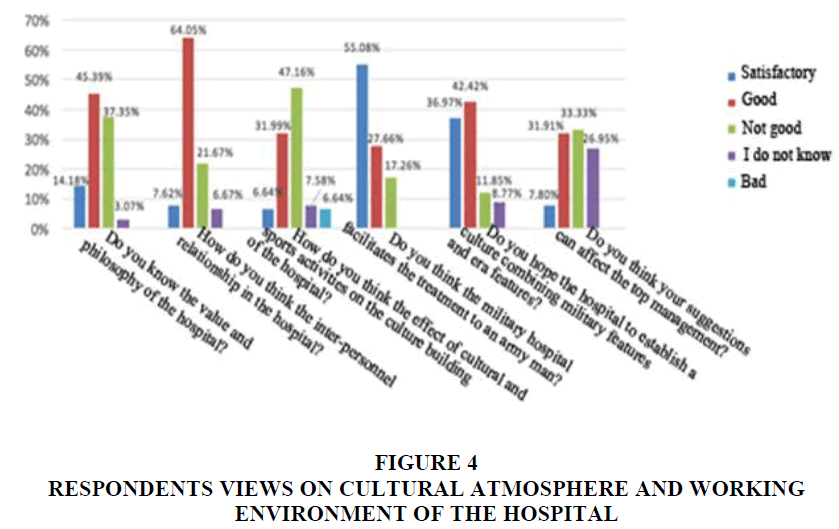Research Article: 2018 Vol: 10 Issue: 1
Investigation and Research On Hr Management of An Affiliated Hospital of Military Medical University In China
Bai Xiu Yin, Chengdu University of Technology, Sichuan
Muhammad Imran Hanif, University of Putra Malaysia
Li Fengsheng, Chengdu University of Technology, Sichuan
Keywords
Military Medical University, Human Resources Management, Survey, Measures, China.
Introduction
The affiliated hospital of the military medical university, not only possess the characteristics of the general public hospitals, the scientific research and teaching institutes and usual military organs, but also its own particularity. Thus its HR management should comply with the basic rules and methods for general hospitals, and moreover, it shall make some customized adjustment according to their own characteristics. The field of human resource management and development started developing in China in the 1980s’ about 20 years later than the western countries. The public Hospitals in China had not started to adopt the human resource management practices to replace the traditional personnel management until the beginning of this century let alone the military hospitals.
Hanif et al. (2018) held that only by better HR management, the overall development of hospitals can be improved based on human capabilities and skills. Weiguo (2006) discussed the organizational structure of human resource in hospitals and believed that the management system should be reconstructed by strategic planning, so that the HR can align with the strategic development of hospitals. Baichao and Liming (2005) made a detailed analysis of post setting for HR in hospitals, and concluded that job analysis was the basic work of human resource management. Dan et al. (2013) believed that job evaluation technology is the fundamental tool of human resource management for hospitals, and that hospitals in China should learn the advanced technology in post evaluation from foreign countries. The literates retrieved reflect clearly that the human resource management and development has been adopted widely in the hospital system. It’s the theoretical research and practical operation have both advanced and developed gradually, and the transformation from a simple concept absorption to detailed implementation has been achieved successfully.
Sifa and Qiang (2005) defined the HR of a military hospital as the total of knowledge, skills, health and other factors of the military hospital personnel, which, through the investment of the state, the army and the individual, can bring about economic income and social benefits to them, and proposed to introduce the concept of human resource management in military hospitals and to establish a new mode of human resource management and development that takes into consideration the military characteristics; suitable for military hospital management. Hongjuan (2008) analyzed in detail the contradictions and problems in the salary distribution in military hospitals, and designed the principles, procedures and restraint mechanism to solve them. Xing et al. (2013) held that HR management of military hospitals began late and progressed slowly, and the construction of human resource echelon was the crucial influencing factor to relieve it. Wan et al. (2014) suggested that performance evaluation of HR in a hospital showed the level of its human resource management, and constructed a new method of performance evaluation from the aspects of both technology and culture.
As we can see, the scholars have made extensive research in recent years on human resource management in military hospitals in China, which provides a basic framework and theoretical basis for the further study of the effectiveness of HR in military hospitals. However, these studies have only made superficial general discussions without testing the pertinence and operability with respect to particular case. It is therefore necessary to obtain more specific and guiding conclusion by make empirical research on some individual cases.
An affiliated hospital of a military medical university is facing an interesting challenge to its existence under the changing circumstances. Either it can continue to exist on ‘as it is’ basis under the traditional military set-up or it can transform itself and move away from the rigidity in the administrative control by applying the latest ideas of HR management, and achieve the commanding heights of talents with advanced and scientific HR management in personnel recruitment, education, post assignment and retaining, to establish a suitable human resource management system combined with its own characteristics. Although the affiliated hospital of a military medical university is already in the process of continuous and steady development, various problems have emerged as the traditional mechanism of human resource management cannot adapt to the significant changes in the organization and structure of existing hierarchy of hospital personnel, such as “gap of academic echelon”, “talent crisis”, little "sense of ownership" of non-military groups, high employee turnover, etc. It is critical and urgent to improve the HR management mechanism of the affiliated hospital of a military medical university keeping in view, the subjective needs of all kinds of staff and to work out HR management methods with characteristics of military hospitals. The paper analyzes the problems faced by the front-line operations team of the hospital, and to further provide the theoretical basis and practical reference for improving and advancing its HR incentive methods and efficiency in the future.
Subjects And Methods
The sample survey-mainly in the form of questionnaire is made among all faculty members and staff of the affiliated hospital of one of the three military medical universities under the general logistics department. As one of the China's first group of third-grade class-A hospitals, the affiliated hospital of a military medical university is a large comprehensive hospital offering multiple facilities of medical treatment, teaching, research, preventive health care and medical support. It has four departments (namely medical teaching department, political department, hospital affairs department and nursing department) managing 45 clinical and paramedical offices, 23 teaching and research offices and the medical imaging department, and undertakes clinical teaching tasks of 13 disciplines and six levels. It has a total covered area of 450,400 square meters with 2,800 beds. The hospital has more than 3,700 staff members, among them about 2,900 are health professionals. It has a faculty of 369 professors and associate professors, 138 doctoral (master’s) advisors and 595 staff with doctoral (master) degree, and non-active civilian personnel and employed staff account for more than 90% of the total professionals. Compared with general public hospitals or affiliated hospitals of ordinary universities, the HR management of the affiliated hospital of a military medical university integrates the personnel management characteristics of general public hospitals, teaching and research hospitals as well as the military, which makes the constitution, management and assessment of its HR a complex task.
The sample survey on the contracted employees based on human resource structure proportion in June 2014 was conducted in the affiliated hospital of a military medical university. A total of 850 questionnaires were sent out, totally 781 questionnaires were collected, of which 727 were valid questionnaires, with an effective response rate of 85.53%. Among all the respondents, 208 (32.50%) have a college degree, 335 (52.34%) with a bachelor's degree, 63 (9.84%) with a master degree of graduate degree, and 34 (5.31%) with a doctoral degree, and respondent’s time in office (Table 1).
| Table 1 Respondent’s Time In Office |
|||
| Number | Item | Number of People | Occupation Ratio |
| A | Within 1 years | 109 | 16.98% |
| B | 1-3 | 186 | 28.97% |
| C | 3-5years | 119 | 18.54% |
| D | More than 5 years | 146 | 22.74% |
| E | More than 10 years | 82 | 12.77% |
The main survey tool is the questionnaire whose variables mainly include four aspects, namely organizational structure and strategic planning, management system and performance assessment, skills training and academic exchanges, cultural atmosphere and working environment, so as to know employees’ opinions on its current system of personnel recruitment, education, post assignment and retention
Results
Organizational Structure and Strategic Planning
Staffs have paid much attention and had high acceptance of the hospitals’ organizational structure and post setting, but they know a little about specific personnel management work and have low acceptance of the future planning.
The survey shows that 29.53% of respondents are highly concerned about the hospital’s current organizational structure, 32.59% are satisfied and 30.08% believe it to be good. When it comes to specific offices, more than half of the respondents (56.63%) think that number of posts and employees are insufficient and need to be increased, 52.24% are good and 15.41 respondents believe that they can satisfactorily exert themselves at the current position; 57.32% recognize that human management in the hospital is good. It can be seen that medical staffs have high attention and recognition on the management organizations of the hospital. 34.27 respondents satisfied but 41.68% respondents think there is phenomenon of “beyond normal channels” and “black-case work” during the personnel management, 56.61% respondents are not familiar with the HR demands of their offices and posts in the next two years, and only 20.29% are satisfied with the career planning by their offices, as shown in Figure 1.
Management System and Performance Assessment
The medical staff have high acceptance for the operation of human resource management system in the hospital, but they are not clear about the process of HR management and unsatisfied with the current salary and incentive.
The survey shows that only 43.40% of respondents consider the HR management of the hospital to be fair; 72.10% view that the HR management system can be implemented strictly. But the employees know little about the HR management processes. 20.42% of respondents are not quite clear about the recruitment mechanism; 39.86% do not know how their performance and achievement is evaluated, which demonstrates that the information disclosure of HR management needs to be improved further. 42.76% of respondents think the current compensation system is not good. 48.58% respondents think it’s good and they know well about how their work is rated as shown in Figure 2.
The high turnover rate of medical personnel is the foremost problem in the HR management. 46% of respondents believe that the biggest problem the hospital has to deal with, is the high employee turnover while the remaining factors, i.e., unreasonable incentive mechanism, non-standardized management policies and unsound performance assessment are chosen by 16%, 13% and 8% of the respondents respectively, as shown in Table 2.
| Table 2 Problems Considered For Hr Management In Hospital By Respondents |
||
| No. | Description | Percentage of Respondents |
| A. | Indefinite long-term planning goals | 6.00% |
| B. | Inadequate senior leadership | 5.00% |
| C. | HR management philosophy inconsistent with the reality | 6.00% |
| D. | Arbitrary management, and no standardized management policies | 13.00% |
| E. | Unreasonable incentive mechanism | 16.00% |
| F. | Unsound performance assessment system | 8.00% |
| G. | High turnover rate of medical staff | 46.00% |
Skills Training and Academic Exchanges
The hospital has a good skills training system and a sound academic exchange, which can satisfy demands of most people, but it shows insufficient concerns on staffs’ professional development.
The survey shows that 47.18% of respondents think that training system of the hospital is not good. 30.02% respondents are of the view that the training courses are not good; 8.81% respondents are satisfied and 61.67% believe that the hospital's academic exchange can meet the needs; 42.69% respondents think that it is not good considering the hospital shows enough concerns on medical staff’s career development; another 32.55% respondents think it is good and 8.25% are satisfied with the hospital showing concern on medical staff’s career development, as shown in Figure 3.
Medical staff has more demands on higher moral quality than on better professional skills. In terms of training content, 39.90% think that the most important issue is the doctors' morality (Table 3). It fully demonstrates that actual attention and recognition of medical workers is on medical ethics and that the benefit-driven pursuit is weakened.
| Table 3 Respondents’ Views On Important Items For Training In Hospital |
||
| No. | Description | Percentage of respondents |
| A. | Doctors' professional skills | 37.60% |
| B. | Doctor's morality | 39.90% |
| C. | Doctor's basic value concepts | 15.09% |
| D. | Others | 7.42% |
Cultural Atmosphere and Working Environment
The hospital’s basic value orientation is accepted by the staff and the overall working atmosphere is good. But the military management style and behaviors are very obvious and the command-driven regime can be found everywhere.
The survey shows that a vast majority of the staff has heard of the value concepts and also the hospital’s pursuit about it, except only 3.07% respondents, who know nothing about it, but even so, 14.18% respondents are satisfied and 45.39% think it is good value philosophy of the hospital. Over 70% believe that interpersonal relationship in the hospital is good, including 7.62% who are satisfied and 64.05% believe it to be good. Around 47.16% think the effect of cultural and sports activities on the cultural building of the hospital is not good. Almost 82.74% believe that the hospital provides convenience for the army man in medical treatment. About 79.32 expect the hospital to build a culture combining military characteristics and era characteristics. With respect to the management’s acceptance of opinions from the grass-roots level, only 7.80% respondents satisfactory and 31.91% are good think it is very helpful to submit the suggestions of the grass-roots level to the management, and 33.33% hold a negative opinion for it and 26.95% they know nothing, as shown in Figure 4.
Discussion And Measures
The opinions of the staff of the affiliated hospital of the military medical university regarding current systems of personnel recruitment, education, post assignment and retention have fully demonstrated the achievements and to-be-resolved problems in HR management of the hospital.
Achievements
The hospital has a sound organizational structure for HR management and complete post setting, a sound professional skills management system, a perfect promotion system and a good channel for human training and recruitment. The basic value is accepted by most staff, the working atmosphere is good, and the living conditions of medical staff have been improved.
Problems
The process of its HR management is indefinite showing serious tendency of formalism, and still stays at the people-rule stage in nature. Administrative command goes before planning service, especially in the aspects of compensation and incentives, which is the foremost problem, and the existing incentives are a kind of "icing on the cake" rather than “timely assistance”.
With regard to the reasons, firstly, the affiliated hospital of the military medical university is an important research and teaching institute and special division of the army, and its organizational hierarchy and administration, essentially, is based on military features, rather than usual medical features. The existing military characteristics e.g. unified management goal, resources allocation and command, are consistent with the requirement of HR management for clear and definite policies and standards. However, this is a kind of static HR management oriented to implementing administrative instructions and controlling staffing. The modern HR management emphasizes on people-centeric ideas, high integration of people and tasks, and advocates employees’ initiative to achieve their self-value, which is a dynamic HR management oriented to free mobility of talents and innovative service. The static and dynamic management have an inherent conflict.
Secondly, the staff of the affiliated hospital of the military medical university presents pluralism, i.e., “military personnel reduced, non-active personnel emerging, and contracted employees as the majority”. However, the HR management team is not so capable to deal with this situation, which resulted in ineffective management. The HR management team mainly consists of clinical professionals and technicians, families of the talents introduced, and the administrative staff recruited. They have neither professional knowledge nor systematic training and practice of HR management, and they have not made any in-depth study on the rules of talent recruitment and training. Even worse is the fact that, they do not have clear understanding of their jobs and responsibilities. So they are unable to provide good service to talents, and instead, they work in a very bureaucratic style. The incidents of conflict with front-line medical personnel are seen from time to time, and incentive measures they formulated are not realistic and thus a source of dissatisfaction to all people. Lastly, besides medical service, the affiliated hospital of the military medical university has important tasks of teaching and scientific research. The staff are highly educated, and most of them are university graduates and under the age of 35. They desire to realize their self-value even under the dual pressures of life and work. For highly educated employees, the task-oriented management is clearly outdated, while participatory management is not likely to get the staff’s response. Both of the traditional modes of HR management have become old-fashioned for the modern hospital system: HR management personnel strive to implement management measures, but their “tricks” have already been seen through by others, who have little enthusiasm.
The following measures are suggested in order to solve the problems found out in the survey:
1. For the diversified employee composition, the affiliated hospital of the military medical university should adopt advanced management methods to motivate talents, abandon the traditional rigid management pattern, establish a new HR incentive mechanism, and reform the existing salary system. First, to set up a corresponding career development path for different types of employees. Second, to realize the career planning of employees throughout the career of the staff. The third is the development strategy of the hospital, and the adjustment of organizational structure is different from the employees.
2. The effort should be undertaken to establish transparent and scientific HR management with the aid of some technical means; To establish a comprehensive system of HR information management in military hospitals, including personnel evaluation subsystem, recruitment information subsystem, education and training subsystem, performance evaluation subsystem, wage and financial subsystem, labor relationship management subsystem, etc. to make human resource planning and demand forecast to ensure the balance of HR supply and demand and introduce the evaluation system to assist in the selection of personnel by means of quantitative technology.
3. Create an atmosphere of equality for post assignment, and assign tasks to outstanding young talents; build a good academic atmosphere, and strengthen the training of professional experts; establish a good cultural atmosphere, and introduce high-caliber talents on a bigger scope. Abolish the lifelong tenure of some posts, compete for posts and participate in it.
4. Combine material and psychological incentives, and while ensuring employees’ material interests, emphasize on moral incentive to motivate their enthusiasm. Competition mechanism should be included in the evaluation and promotion of technical posts, not only depends on the age of qualification, but also on scientific research results, so that everyone has the opportunity.
The medical staff of the affiliated hospitals of the military medical university assume great social responsibility and highly intensive and demanding technical jobs that require good teamwork, which stresses more on staff’s dedication and social responsibility. Therefore, its management of staff shall be “people-oriented” while in the framework of “management by the Communist Party of China”, and give full play of employees’ advantages while encouraging competition.
References
Carsten, C.S., Michael, D., & Ronald, G. (2015). Human resource crises in German hospitals an explorative study. Human Resource and Health, 13, 25-40.
Hanif, M.I., & Shao, Y. (2015) Collaborative Innovation of Strategic Emerging Industries: A Case Study of the New Generation of Information Technology Enterprises in China. IBT Journal of Business Studies, 13(2), 101-123.
Huong Nguyen, T.L. (2016). Building human resources management capacity for university research: The case at four leading Vietnamese universities, Higher Education, 71(2), 231-251.
Lang, H.J. (2008). Design principles and methods of hospital compensation. Hospital administration. Journal of Chinese People's Liberation Army, 2, 120-154.
Mayes, B.T., Finney, T.G., & Johnson, T.W. (2017). The effect of human resource practices on perceived organizational support in the People's Republic of China. International Journal of Human Resource Management, 28(9), 1261-1290.
Qu, X., Wang, M., & Wang, M. (2013). Construction and incentive of human resource strategic hierarchy of affiliated hospital of universities West China dental hospital of Sichuan University as an example. Soft Science, 4(27), 110-125.
Samolejová, A., Wicher, P., & Lampa, M.R. (2015). Factors of human resource planning in metallurgical company. Journal of Metalurgija, 54(1), 243-246.
Sun, X., Bernabé, E., Liu, X., Zheng, S., & Gallagher, J.E. (2017). Meeting the oral health needs of 12-year-olds in China: Human resources for oral health. BMC Public Health, 17(1), 480-586.
Wan, A.H., Zhou, Y., & Yan, L.L. (2014). Hard and soft information in human resources performance evaluation of affiliated hospital of universities Tongji Hospital as an example. Chinese Health Service Management, 3 (31), 156-174.
Zhang, D., Zeng, Y., & Zhang, T.S. (2013). Analysis on the development trend of hospital post evaluation technology. Chinese Journal of Public Health, 1(29), 110-155.



